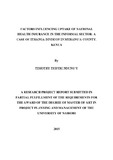| dc.description.abstract | The purpose of the study was to investigate the factors influencing the uptake of National
Health Insurance in the informal sector in Ithanga Division, Murang’a County, Kenya. The
study was guided by four specific objectives; (1) To assess the influence of demographic
factors on uptake of health insurance in the informal sector (2) To determine the influence of
level of education on uptake of health insurance in the informal sector (3) To assess the
influence of economic factors on uptake of health insurance in the informal sector and (4) To
establish the influence of level of awareness on uptake of health insurance in the informal
sector in Ithanga Division, Murang’a County. The study adopted a descriptive survey
research design. The study population was the 4555 households among 19,359 residents:
9330 males and 10,013 females of Ithanga Division of Murang’a County. The study used
stratified systematic sampling techniques to sample 354 respondents. A questionnaire (HHQ)
was used to collect data from the households’ heads. Piloting of the instrument was carried
out in Makuyu Division using a sample of 35 households’ heads representing 10% of the
study sample of 354. Split-half technique was used to determine to determine the reliability
of the questionnaire. A correlation coefficient(r) value of 0.89 was obtained. The data for the
main study was collected for a period of one week with the aid of three trained research
assistants. After cleaning the data, coding was done and then analyzed using Statistical
Package for Social Sciences (SPSS version 21.0). Quantitative data were analyzed using
descriptive statistics such as frequencies, and percentages. Findings were then presented in
frequency distribution tables. Qualitative data were analyzed thematically. The study found
more females (18.90%) had enrolled compared to males (14.53%). Those aged 46 years and
above had a higher enrollment of 49 (14.2%), and the married had a higher enrolment of 79
(23.0%), Level of education was significant in influencing their decisions to enroll.
Enrollment for people with higher incomes and those who were affiliated to social welfare
groups. The out awareness of NHIF registration procedures, premium payment mechanisms
and the benefit packages is low and this greatly influenced the uptake of the cover. The study
concluded that demographic factors (including gender, age, marital status, household size and
the number of children in the household), level of education, socio-economic factors and
awareness had influence on the uptake of NHIF in the informal sector. The study
recommended the need to increase the awareness about health insurance, subsidizing the
premiums, review of premiums payment period, extending the NHIF office network and
increasing the number of health facilities. The study recommends further studies to
investigate the influence of culture and religion in enrollment decisions, the extent of adverse
selection in the enrollment, and the factors influencing retention and dropout from the
insurance scheme and dropout from the insurance scheme. | en_US |

